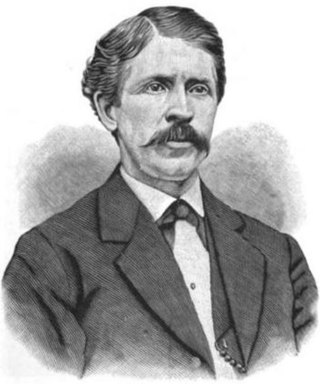
Two corps of the Union Army were called VII Corps during the American Civil War.

Frederick Steele was a career military officer in the United States Army, serving in the Mexican-American War, the Yuma War, and as a major general in the Union Army during the American Civil War. He was most noted for retaking much of secessionist Arkansas for the Union cause, escaping the besieged port-city of Camden through successful deception tactics, and defeating Sterling Price and E. Kirby Smith at Jenkins Ferry.
The Battle of Prairie D'Ane, also known as the Skirmish at Prairie D'Ane, Battle of Gum Springs, or Battle of Moscow, was fought in present-day Nevada County, Arkansas, as part of the Camden Expedition, during the American Civil War. The Camden Expedition was launched by Union forces as part of the Red River Campaign of 1864. U.S. planners envisioned two federal armies converging simultaneously, one force under the command of Maj. Gen. Nathaniel Banks pressing northward up the Red River commencing at Alexandria, Louisiana and the other federal army under the command of Maj. Gen. Frederick Steele driving southwestward from Little Rock, Arkansas. The objective was to press the rebel army of Gen. E. Kirby Smith back upon the rebel stronghold at Shreveport and defeat him. If successful, a somewhat vague second phase envisioned the two federal armies combining into one large force and continuing their offensive with a westward push into Texas.

The 27th Wisconsin Volunteer Infantry Regiment was an infantry regiment that served in the Union Army during the American Civil War. The regiment began organizing in August 1862 but recruiting problems delayed its entry into federal service until March 1863. Predominantly from the Lake Michigan shore counties of the state, the regiment was mainly composed of German immigrants. The 27th Wisconsin played a supporting role in the Siege of Vicksburg and participated in the capture of Little Rock, Arkansas during the year. The regiment served in the Little Rock garrison and saw its first serious combat in the Camden Expedition of 1864, during which it fought in the Battle of Jenkins' Ferry. The regiment was among the Union forces in the Mobile campaign in early 1865, and was involved in the Battle of Spanish Fort. Ending the war in the occupation of Texas, the regiment was mustered out in August before returning to Wisconsin.

During the American Civil War, Arkansas was a Confederate state, though it had initially voted to remain in the Union. Following the capture of Fort Sumter in April 1861, Abraham Lincoln called for troops from every Union state to put down the rebellion, and Arkansas along with several other southern states seceded. For the rest of the civil war, Arkansas played a major role in controlling the Mississippi River, a major waterway.
The 36th Iowa Infantry Regiment was an infantry regiment that served in the Union Army during the American Civil War.
The 77th Ohio Infantry Regiment, sometimes 77th Ohio Volunteer Infantry was an infantry regiment in the Union Army during the American Civil War.
The 30th Arkansas Infantry (1862–1865) was a Confederate Army infantry regiment during the American Civil War. This regiment was also called the 5th Arkansas Cavalry, the 5th Trans-Mississippi Regiment or 39th Regiment after April, 1863. This regiment was converted to mounted infantry for Price's Missouri Expedition in 1864 and was known as Rogan's Arkansas Cavalry. There were two regiments officially designated as the 30th Arkansas Infantry. The other 30th Arkansas served east of the Mississippi River and was redesignated as the 25th Arkansas Infantry.
The 19th Arkansas Infantry Regiment or Dockery's Arkansas Infantry Regiment was an infantry formation of the Confederate States Army during the American Civil War. There were two other regiments which were designated as the 19th Arkansas. Dawson's 19th Arkansas Infantry was organized at Nashville, Arkansas, on November 21, 1861. Hardy's Arkansas Infantry, which is also occasionally referred to as the 19th Arkansas was organized in 1863 from those parts of Dawson's 19th Infantry Regiment, the 24th Arkansas Infantry Regiment and Crawford's Arkansas Infantry Battalion, which escaped capture at the Battle of Arkansas Post.
The 38th Arkansas Infantry (1862–1865) was a Confederate Army infantry regiment during the American Civil War. The unit was often referred to as Shaver's Arkansas Infantry. The unit served in the Department of the Trans-Mississippi from its formation in the summer of 1862 until its surrender in May 1865.
Benjamin Franklin Gordon, commonly known as B. Frank Gordon, was a Confederate States Army colonel during the American Civil War. Gordon had been a private and bugler for a Missouri regiment serving in the U.S. Army during the Mexican–American War. Gordon served in the Confederate Army under Brigadier General Joseph O. "Jo" Shelby in Missouri and Arkansas in the Confederate Trans-Mississippi Department throughout the war. On May 16, 1865, with the war coming to an end, General E. Kirby Smith, as the Confederate commander of the Trans-Mississippi Department, assigned Gordon to duty as a brigadier general. The Confederate government took no action on the appointment and Confederate President Jefferson Davis did not officially appoint and nominate Gordon to the rank of brigadier general because the Confederate Senate last met on March 18, 1865, and Davis was captured by Union troops on May 10, 1865. Although he was only aged 40 at his death, Gordon survived the war by little more than a year.

The 1st Arkansas Light Artillery Battery (1863–1865) was an artillery battery that served in the Union Army during the American Civil War. Although Arkansas joined the Confederate States of America in 1861, not all of its citizens supported secession.
The 50th Regiment Indiana Infantry was an infantry regiment that served in the Union Army during the American Civil War.
The Department of the Arkansas was a territorial department of the United States Army during the American Civil War.
The Skirmish at Terre Noire Creek, also known as the Skirmish at Wolf Creek or Skirmish at Antoine, an engagement during the Camden Expedition of the American Civil War, was fought on April 2, 1864. The action occurred about 1 mile (1.6 km) east of Terre Noire Creek along a defile near the towns of Hollywood, Arkansas and Antoine, Arkansas. A Confederate States Army cavalry brigade under Brigadier General Joseph O. Shelby attacked a Union supply train of more than 200 wagons accompanying Union Army Major General Frederick Steele's force which was attempting to reach Shreveport, Louisiana to join with Major General Nathaniel Banks's force in the Red River Campaign with the objective of occupying Shreveport and controlling western Louisiana.

The 1st Missouri Volunteer Cavalry Regiment was a cavalry regiment with three battalions that served in the Union Army during the American Civil War from 1861 to 1865.
The 3rd Missouri Cavalry Regiment was a cavalry regiment of the Confederate States Army during the American Civil War. It was also known as Greene's Regiment after its commander, Colonel Colton Greene.

The Springfield Illinois Light Artillery, also known as Vaughn's Independent Illinois Battery or Battery A, 3rd Illinois Light Artillery, was an artillery battery from Illinois that served in the Union Army during the American Civil War. Organized in August 1862, the unit was first stationed at Bolivar, Tennessee. In August–September 1863 the battery participated in Frederick Steele's expedition to Little Rock, Arkansas, being engaged at Bayou Fourche. In spring 1864, the battery took part in the Camden Expedition, fighting at Prairie D'Ane and Jenkins' Ferry. The unit sat out the remainder of the war in Little Rock before being mustered out of service in June 1865.

The 1st Missouri Field Battery was a field artillery battery that served in the Confederate States Army during the American Civil War. The battery was formed by Captain Westley F. Roberts in Arkansas in September 1862 as Roberts' Missouri Battery and was originally armed with two 12-pounder James rifles and two 6-pounder smoothbore guns. The unit fought in the Battle of Prairie Grove on December 7, as part of a Confederate offensive. Roberts' Battery withdrew after the battle and transferred to Little Rock, Arkansas, where Roberts resigned and was replaced by Lieutenant Samuel T. Ruffner.
The Little Rock Campaign, officially known as Advance of the Union forces upon Little Rock, Arkansas, was a campaign conducted by the Union Army in Arkansas during the American Civil War. The strategic offensive was designed to capture Little Rock.








